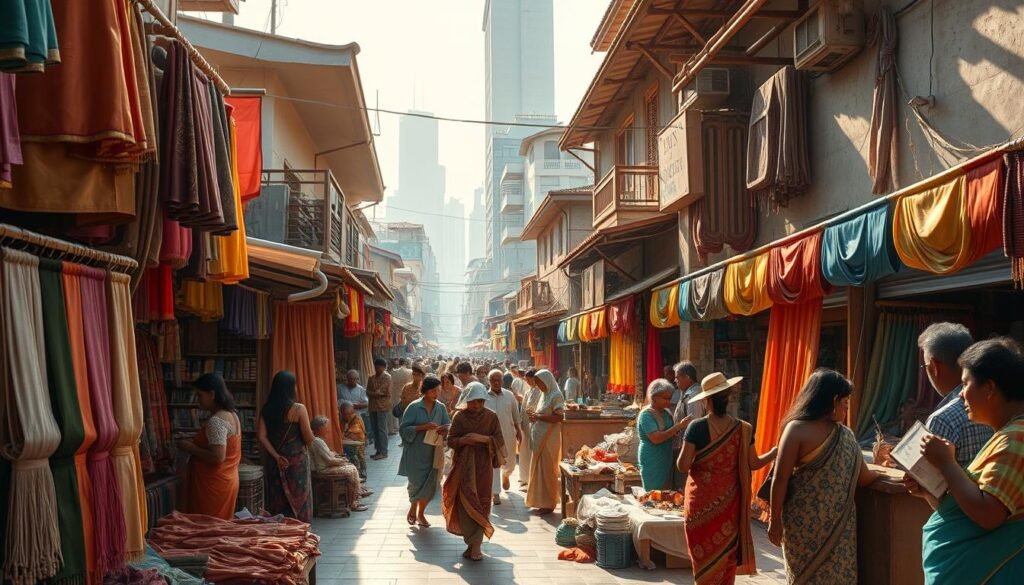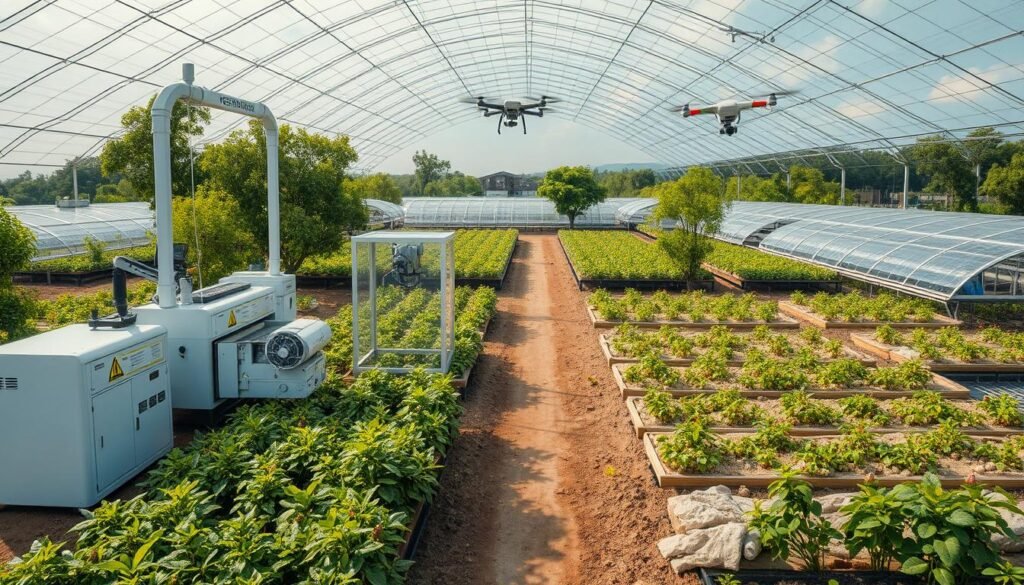Did you know the global silk market is set to grow from about USD 20.0 billion in 2024 to USD 44.6 billion by 2034? This is a growth rate of 8.4% each year. The demand for silk is rising fast, mainly in places like China and India. This is because more people are looking to buy luxury textiles.
As the silk market grows, it’s clear that people from all walks of life find silk appealing. This is because of its quality and elegance.
Also, new tech in silk making is making it more sustainable and innovative. Companies like Tianruiyi are at the forefront of this change. They make custom silk pajamas that are both luxurious and personalized. This meets the needs of today’s consumers who want both style and eco-friendliness.
With more money to spend and changing lifestyles, Asian markets are key. They are embracing luxury textiles that make their daily lives more appealing and comfortable. To learn more about silk’s luxurious side, check out custom silk pajamas from Tianruiyi. They combine elegance with personal touches.
Key Takeaways
- The silk market is projected to double in value, reaching USD 44.6 billion by 2034.
- Emerging markets, mainly in Asia, are leading the surge in silk demand.
- Technological innovations are modernizing silk production methods.
- High-quality silk products, like custom pajamas, are becoming highly sought after.
- Eco-friendly practices are shaping consumer preferences in the silk industry.
Overview of the Global Silk Market
The global silk market has shown strong growth and resilience in recent years. It was valued at $15.6 billion in 2021. By 2031, it’s expected to hit around $34.1 billion, growing at 8.2% annually from 2022 to 2031.
This growth is driven by several factors. Changing consumer tastes, higher disposable incomes, and new technologies are key. These elements boost the demand for silk products.
Market Trends and Projections
Luxury silk textiles are in high demand, mainly in the fashion world. Mulberry silk is expected to grow the fastest. This is because it’s of high quality and has health benefits like being antibacterial and hypoallergenic.
The textile industry is the biggest user of silk products worldwide. It plays a huge role in the market.
Industry Growth Rate
Several factors drive the silk market’s growth. The demand for silk protein is increasing in various sectors, including cosmetics and pharmaceuticals. This opens up new opportunities for producers.
Technological advancements, like AI and IoT, have also played a big part. Companies like ReshaMandi have introduced these technologies. They improve silk production processes and quality, keeping the market moving forward.
| Year | Market Value (in USD Billion) | Growth Rate (%) |
|---|---|---|
| 2021 | 15.6 | – |
| 2024 | 20.0 | 8.0 |
| 2031 | 34.1 | 8.2 |
Historical Context of Silk Production
The story of silk production is deeply rooted in ancient practices. It shows a remarkable journey through time. Starting in Neolithic China, this craft has changed through many cultures and societies over thousands of years. Knowing about sericulture history helps us see how this luxurious fabric has stayed important and changed across regions.
Origins of Sericulture
Sericulture started around 3630 BC when silk was first found by Empress Hsi-Ling-Shih. The Yangshao culture in 4th millennium BC China was the beginning of silk production. China had a near monopoly on silk for centuries, thanks to the Silk Road opening in 114 BC. This road connected East and West, spreading silk knowledge to places like Japan, Korea, and India.
Traditional Silk Making Techniques
Traditional silk making involves raising silkworms and manual weaving. These silk production techniques have been kept alive for generations. They show the artistry and hard work needed in silk making. Silk was once only for emperors and high dignitaries, used in clothes, writing, and musical instruments. This link shows how silk became important in different societies over time.
Market Dynamics Influencing Demand
The silk market is growing fast, thanks to many factors. These factors drive up demand but also face challenges. Knowing these dynamics helps industry players keep up with changes.
Key Drivers of Silk Demand
Technology in sericulture is making silk production better and more efficient. The textile industry’s growth also boosts demand for silk. People want sustainable materials, which is good for silk.
The silk market is expected to reach USD 106.19 billion by 2031. It’s growing at a 6.8% CAGR. This shows demand is on the rise.
Restraints Affecting Market Growth
Despite the growth, there are challenges in the silk industry. The reliance on Chinese raw silk can cause supply chain issues. High production costs make it hard for new players to enter.
These problems make it tough for companies to stay competitive. They need to find ways to overcome these hurdles to keep growing.
Demand for Silk in Emerging Markets
The silk demand in emerging markets is growing fast, mainly in the Asia-Pacific area. This growth comes from higher incomes and a bigger middle class wanting luxury. Countries like China, India, Vietnam, and Thailand lead this trend, thanks to their silk-making history and good infrastructure.
The global silk market was worth USD 20.91 billion in 2023. It’s expected to hit USD 35.63 billion by 2031, growing at 7.60% annually. This increase is due to changing fashion trends and more people wanting sustainable fibers.
Silk’s popularity keeps rising in fashion and garments. It’s seen as a symbol of luxury and quality. People are looking for silk in clothes like shirts, ties, lingerie, and kimonos, as well as in high-end accessories. The textile sector is the biggest user of silk.
There’s a growing interest in sustainable silk production in emerging markets. This shift is making the industry more eco-friendly. New technologies like mulberry-free silk and high-tech uses are opening up new areas. Digital tools like blockchain and IoT are also making the silk supply chain more transparent and trustworthy.

As emerging markets grow, the silk industry faces challenges like synthetic fiber competition and high costs. But, the demand for silk looks bright, promising a strong future for this luxury textile.
Silk Applications Across Industries
Silk is used in many industries, showing its wide appeal and value. The textile industry uses the most silk, thanks to a focus on quality and sustainability. Silk is also gaining ground in medicine and cosmetics, expanding its use even more.
Textile Usage and Fashion Trends
The textile industry loves silk for making fancy clothes and accessories. In 2019, it made up over 70% of the silk market. This is because people want sustainable fashion, and silk fits the bill.
Mulberry silk is leading the way in this trend. It’s expected to grow even more because it’s so popular in fashion.
Medical and Cosmetic Applications
Silk is also making waves in healthcare. Silk fibroin is used in skincare for its protective and anti-aging benefits. The healthcare segment of the silk market is growing fast, valued at about USD 1,576.4 million.
Silk sutures are also popular in surgery because they’re safe and work well. Cosmetic silk is combining beauty with function, making it even more appealing.
Technological Advancements in Sericulture
The silk industry is going through a big change thanks to new technology. These changes focus on making things better, faster, and more eco-friendly. This is key for meeting today’s market needs.
New genetic engineering methods have boosted silk production. Scientists have made silkworms that grow more and are healthier. This helps make silk production more efficient and meets the growing demand for silk.
Automation has also changed sericulture a lot. It makes raising silkworms, picking cocoons, and making silk easier and cheaper. It also helps protect the environment. This technology is helping small silk producers in new markets to keep up with big players like China and India.
New markets are changing the silk world with tech like AI and IoT. These tools help farmers grow silk better by using data and sensors. This leads to more silk and less waste, helping the environment.
Technology is also helping fight diseases in silkworms. New tools can spot diseases early and manage pests better. This keeps silkworms healthy and reduces the need for harmful chemicals.
The silk industry is growing, and being green is key. Producers are working to use less waste, recycle, and use clean energy. This makes silk more appealing to buyers and helps the industry grow.

| Advancements | Description | Impact on Silk Production |
|---|---|---|
| Genetic Engineering | Development of improved silkworm breeds | Higher yields and disease resistance |
| Automation | Automated rearing and harvesting systems | Reduced labor costs and increased efficiency |
| AI and IoT | Precision farming and data analytics | Optimized cultivation and enhanced productivity |
| Disease Management | Advanced diagnostic and pest management tools | Improved silk quality with lower chemical use |
| Sustainability Practices | Waste reduction and renewable energy integration | Support for eco-friendly silk production |
Consumer Preferences Influencing Market Growth
Consumer preferences are changing the silk industry. People now care more about sustainable and eco-friendly options. This is true, even for those who love luxury.
More buyers want brands that are good for the planet. They look for companies that use green production methods.
Sustainability and Eco-Friendly Practices
There’s a big push for eco-friendly silk. Consumers want brands that focus on being green. This is part of a bigger trend towards buying things that are good for the environment.
Concerns about health during silkworm rearing are also growing. People want to know how their silk is made. This means brands that are open about their practices are getting more attention.
Lifestyle Changes and Luxury Consumption
Lifestyle changes are making people want more from their clothes. They’re looking for comfort and luxury. Silk fits the bill perfectly.
The love for silk is growing, not just in clothes but also in home decor. The North American silk market is expected to grow a lot. It’s set to jump from USD 3 billion in 2023 to USD 5.04 billion by 2030.
| Consumer Preferences | Impact on Silk Market |
|---|---|
| Sustainable Practices | Increased demand for eco-friendly silk products |
| Luxury Consumption | Growth in high-end silk applications in fashion and cosmetics |
| Health and Transparency | Shift towards brands that ensure responsible sourcing and production |
| Versatile Textiles | Rising acceptance of silk in everyday wear and luxury home goods |
The North American market loves mulberry silk. It’s known for being top-notch and versatile. This shows that people want both comfort and style.
Regional Insights: Asia-Pacific as a Silk Hub
The Asia-Pacific region is a major player in the global silk industry. This is thanks to China’s silk industry and India’s silk market. The area excels in sericulture, has strong production infrastructure, and values silk deeply.
Leading Producers: China and India
China is the top silk producer, focusing on mulberry and Tussar silk. It has made key innovations to improve silk quality and efficiency. India, on the other hand, is known for its traditional silk sarees and local weaving traditions.
States like Karnataka, Andhra Pradesh, and Assam are big contributors to India’s silk market. They show a mix of cultural richness and economic growth.
Emerging Markets in Southeast Asia
Southeast Asia is seeing a rise in silk production. This is thanks to local traditions and modern methods. Countries here are investing in silk, meeting growing demand for quality and luxury items.
This shift in consumer preferences is boosting the silk industry in Asia-Pacific. For more on market trends, check out this link.
| Country | Silk Type | Key Contributions | Market Share (%) |
|---|---|---|---|
| China | Mulberry, Tussar | Innovative production techniques | Approx. 35 |
| India | Mulberry, Tussar, Eri | Traditional sarees and local craftsmanship | Approx. 25 |
| Southeast Asia | Local varieties | Emerging producers and traditional practices | Approx. 15 |
| Japan | High-end silk | Luxury silk products | Approx. 10 |
| Others | Various | Minor contributions | Approx. 15 |
Challenges Faced by the Silk Industry
The silk industry faces many challenges that affect its growth and sustainability. High production costs are a big problem, mainly because making silk is very labor-intensive. This makes it hard to stay profitable and stable in the market.
The environmental impact of silk farming is also a concern. Weather conditions can harm silkworms, leading to inconsistent production. This affects the quality and quantity of silk produced.
Production Costs and Labor Intensity
High silk production costs are a major challenge. The process of making silk is very labor-intensive, which increases expenses. For example, India, the second largest silk producer, has about 9.76 million people working in this field.
Even though China produces most of the world’s silk, the costs are similar in both countries. This shows the labor-intensive nature of silk production.
Environmental and Climatic Impacts
The environmental impact of silk farming is significant. Bad weather can greatly reduce silk production. Diseases like flacherie and muscardine also harm silkworms, leading to high mortality rates.
These issues make it harder for the silk industry to compete with synthetic and blended fibers. Adopting sustainable practices and advanced technology could help overcome these challenges.
Conclusion
The silk market looks bright, with a growing demand in emerging markets. This is due to economic growth and a desire for luxury sustainable products. The market value is expected to hit USD 41,428.9 million by 2033, showing a 6.8% growth rate from 2024 to 2033.
People are now looking for high-quality and eco-friendly textiles. This shift is driving the industry’s growth. It shows that consumers are changing their preferences.
Innovation and technology are key in the silk industry’s future. Brands like Kraig and AmSilk are working on sustainable products. This shows the industry’s ability to adapt.
Despite challenges like high production costs and environmental concerns, new opportunities are arising. These opportunities are in clothing, accessories, cosmetics, and home textiles. This means silk is becoming more versatile.
As the market evolves, it’s important to keep up with trends and consumer values. Companies need to understand regulatory frameworks and what consumers want. This will help them find new investment areas.
The mix of tradition and innovation will shape silk’s future in global markets. It will ensure silk remains a luxury textile for years to come.
FAQ
What factors are driving the demand for silk in emerging markets?
In emerging markets, the love for silk is growing. People have more money to spend and want to look good. Countries like China and India are leading this trend.
What is the projected growth of the global silk market?
The silk market is set to boom. It’s expected to hit USD 44.6 billion by 2034. This is a growth rate of 8.4% each year.
What are some traditional techniques used in silk production?
Making silk the old way is hard work. It involves raising silkworms and weaving by hand. These methods have been around for over 6,000 years, mainly in Asia.
What challenges does the silk industry face?
The silk industry has big challenges. It’s expensive to make silk because it’s so labor-intensive. Also, it can harm the environment, affecting silkworms and silk quality.
How is silk utilized in various industries?
Silk is mostly used in making fancy clothes, like wedding dresses. It’s also used in medicine, like sutures, and in beauty products, like skincare.
What technological advancements are being made in sericulture?
New tech is making silk production better. It’s improving how silkworms are bred and how silk is made. This makes silk better and more sustainable.
How are consumer preferences impacting the silk market?
People want products that are good for the planet. This is making the silk market grow, mainly in the luxury sector. High-quality silk is seen as eco-friendly.
Which regions are leading silk production?
Asia leads in silk production. China makes the most, focusing on mulberry and Tussar silk. India is famous for its silk sarees. Southeast Asia is also growing fast.
What is the significance of luxury textiles in the silk market?
Luxury textiles, like silk, are in high demand. People want sustainable fashion. This trend is boosting the silk market, showing a shift towards quality and luxury.




